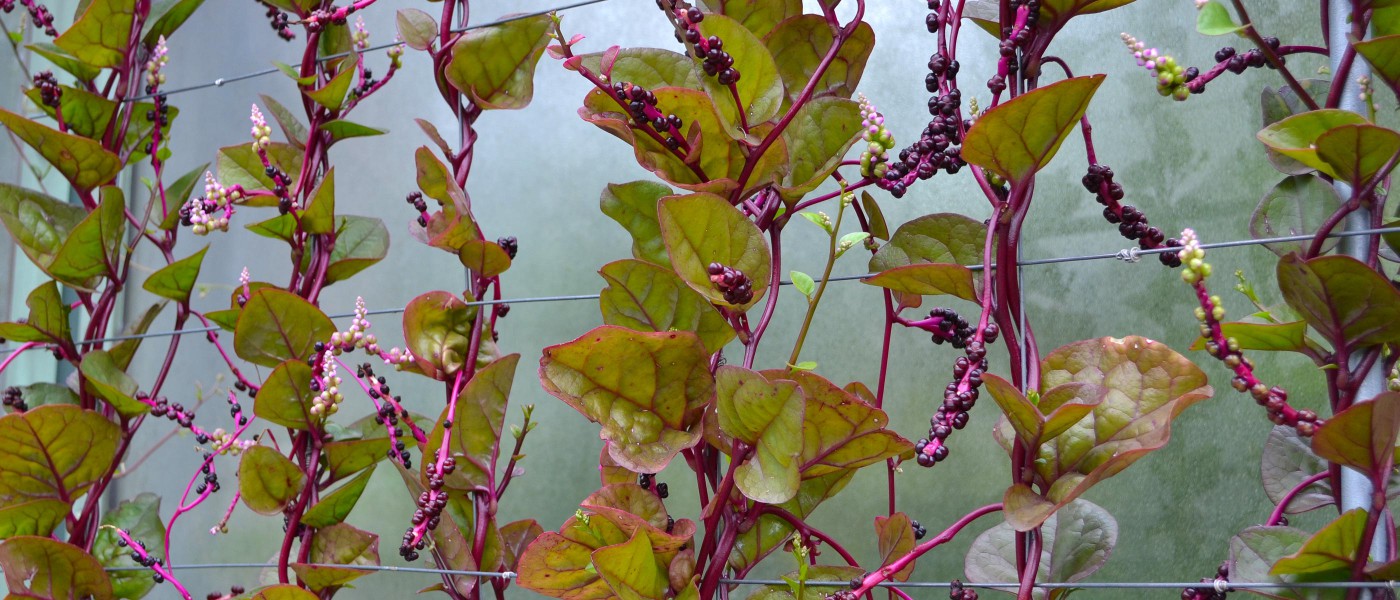Red-Stemmed Malabar Spinach
One of my favorite hot-weather vegetables is red-stemmed Malabar spinach, Basella alba 'Rubra'. Easy to grow, versatile in the kitchen, and delicious to eat, this vigorous vine is unrelated to true spinach (Spinacia oleracea) but produces abundant large meaty leaves that are remarkably spinachlike in taste and form. The plant is also much better suited for summer growing than its better-known namesake.
Oh, and I forgot to mention this: It's a thing of beauty. A number of years ago, I visited Wave Hill gardens, in the Bronx, New York, and saw red-stemmed Malabar spinach twining on a trellis and forming the backdrop for a display of dark-leafed cultivars of common economic crops—purple-stemmed sugarcane, black-leafed cotton, aubergine-colored beets, kale, and Swiss chard. The combination knocked my socks off!
Basella alba goes by many other common names besides Malabar spinach, including Ceylon spinach, Indian spinach, vine spinach, and Malabar nightshade. Native to India and Indonesia (Malabar is a coastal region in southwestern India), the plant is used in traditional cuisines as far westward from its point of origin as Japan and eastward as Africa. It has also been introduced to South America and the Caribbean.
Straight species Malabar spinach has yellowish stems and green leaves and is a pleasing enough plant, but it's the red-stemmed cultivar 'Rubra' that really catches the eye (whether it's growing in a pot or lounging in a salad bowl). The thick red stems contrast wonderfully with the round, highly textured, two- to four-inch-long dark green leaves. Red venation in the leaves adds another level of color contrast.
Malabar spinach grows eight to ten feet tall and wide and produces inconspicuous white-tinged pink flowers in its leaf axils. Upon fertilization, the flowers develop into small, highly ornamental, single-seeded purple berries. The juice from the berries is so intensely purple that it puts beet juice to shame. It's used as a natural food colorant for agar (vegetable "gelatine") dishes, sweets, and pastries.
Malabar spinach excels in warm, tropical areas, where it can easily grow a foot per day. It's intolerant of any chills; thus, the only regions in the U.S. where it would be perennial are the Deep South or southern Florida. Gardeners in colder climates can grow it as an annual.
Basella alba prefers a humus-rich, sandy loam in full sun. Seeds can be sown in situ after all danger of frost has passed, or they can be started indoors eight weeks before the last frost date, hardened off outside, and transplanted one foot apart. Use any style of plant support you prefer: poles, teepees, chain-link fencing—I use a tall, recycled Eiffel Tower-esque metal étagère missing its glass shelves. Malabar spinach is amazingly insect and disease resistant, and that is saying a lot; down here in Puerto Rico, legions of caterpillars and grasshoppers can decimate an entire planting overnight, yet the spinach remains untouched!
Propagation from seed is a snap, and happily, the red-stemmed cultivar of Malabar spinach comes true from seed. Saving seed is easy too: Simply dry the entire fruit and use it for planting the following year. Stem and tip cuttings may be employed as well. (One source for the plant is Shady Acres Herb Farm, 7815 Highway 212, Chaska, MN 55318; 952-466-3391; www.shadyacres.com.)
The succulent leaves and stem tips are rich in vitamins A and C and are a good source of iron and calcium. They may be eaten raw in salads, boiled, steamed, stir-fried, or added to soups, stews, tofu dishes, and curries. Or you can use them as a filling for quiche, omelets, savory turnovers, and potpies. Since red-stemmed Malabar spinach can lose a lot of its red color when cooked, perhaps it is best utilized (visually speaking) in raw dishes.
Indonesian-Style Malabar Spinach
- 4 cups Malabar spinach leaves
- 3 tablespoons peanut oil
- 3 garlic cloves, finely chopped
- ½-inch piece galangal root or fresh ginger root, peeled and finely chopped
- 1 red chile pepper, seeded and slivered lengthwise
- 1¾ cups cream of coconut (not coconut milk)
- ¼ cup fresh lime juice
- ¼ teaspoon salt
- 1 scallion sliced into thin rings, including green tops
- 2–4 fresh kaffir lime leaves, or 2 dried leaves pulverized in a spice mill
Gently sauté the galangal, garlic, and chile in the oil for a few minutes, then stir in the greens and cook until they are wilted through. Drain off excess liquid. Combine the remaining ingredients in a medium-size, heavy-bottomed saucepan and heat to a bare simmer, stirring constantly. Do not let it boil. Add the cooked greens and mix. Serve warm.


